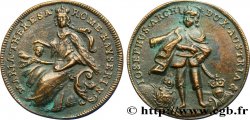v23_1945 - 10 francs Cérès, Troisième république 1889 Paris F.508/2
MONNAIES 23 (2004)
Starting price : 5 800.00 €
Estimate : 8 500.00 €
unsold lot
Starting price : 5 800.00 €
Estimate : 8 500.00 €
unsold lot
Type : 10 francs Cérès, Troisième république
Date: 1889
Mint name / Town : Paris
Quantity minted : 100
Metal : gold
Millesimal fineness : 900 ‰
Diameter : 18,8 mm
Orientation dies : 6 h.
Weight : 3,23 g.
Edge : striée
Rarity : R3
Coments on the condition:
Frappe d’épreuve. Les stries de polissage du coin sont parfaitement visibles (dans l’axe de la monnaie) au revers, à l’œil nu. Les reliefs sont en camée par rapport aux champs brillants miroir. Le velours d’origine est quasiment intact avec une infime marque sur le rebord de la narine au droit (ce qui nous fait mettre FDC 65 - seulement ! - et donc ce n’est pas l’exemplaire de la COLLECTION IDÉALE). Un exemplaire saisissant de cette rarissime monnaie
Catalogue references :
Obverse
Obverse legend : REPUBLIQUE - FRANÇAISE.
Obverse description : Tête de Cérès couronnée d'épis entre un faisceau de licteur surmonté d'une main de Justice, le tout sous une étoile à six rais ; signé L. MERLEY au-dessous.
Reverse
Reverse legend : LIBERTE EGALITE FRATERNITE/ 1896// 10/ FRANCS// A.
Reverse description : Légende circulaire ; dans une couronne formée d'une branche d'olivier à gauche et d'une branche de chêne à droite.
Commentary
Flan bruni. Frappé à 100 exemplaires à l’occasion de l’Exposition universelle.
Burnished flan. 100 examples minted for the World's Fair.
Burnished flan. 100 examples minted for the World's Fair.








 Report a mistake
Report a mistake Print the page
Print the page Share my selection
Share my selection Ask a question
Ask a question Consign / sell
Consign / sell
 Full data
Full data















